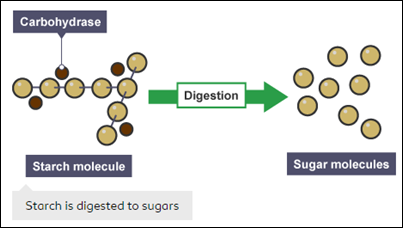Why starch digestion started in the mouth ceases when food reaches the stomach?
The digestive system is the organ system that breaks food down into small molecules that are absorbed into the bloodstream. Digestion is helped by enzymes, which are biological catalysts.
Carbohydrates are digested in the mouth, stomach and small intestine. Carbohydrase and amylase enzymes break down starch into sugars.

The saliva in your mouth contains amylase, which is another starch digesting enzyme.
The digestion of carbohydrates begins in the mouth. The salivary enzyme amylase begins the breakdown of food starches into maltose, a disaccharide. As the bolus of food travels through the esophagus to the stomach, no significant digestion of carbohydrates takes place. The esophagus produces no digestive enzymes but does produce mucous for lubrication. The acidic environment in the stomach stops the action of the amylase enzyme.
The next step of carbohydrate digestion takes place in the duodenum. The chyme from the stomach enters the duodenum and mixes with the digestive secretion from the pancreas, liver, and gallbladder. Pancreatic juices also contain amylase, which continues the breakdown of starch and glycogen into maltose, a disaccharide.
EXPLANATION: Starch digestion starts in the mouth with amylase enzymes and finishes in the small intestines where more amylase is released by the pancreas in the duodenum. Amylase from the saliva in the mouth does not die in the stomach - it goes dormant because it needs an alkaline environment to be active. It get re-activate in the duodenum when the acid material from the stomach is neutralized by bicarbonate secrete from the pancreas.